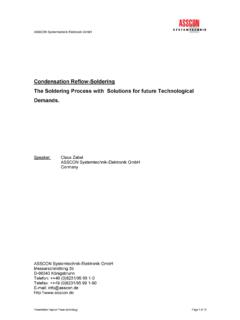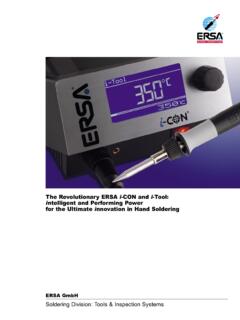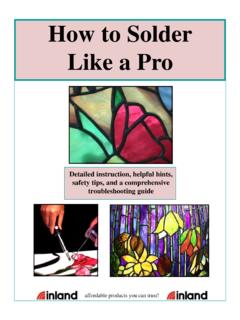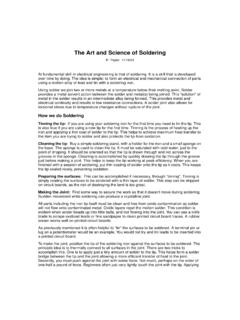Transcription of Soldering Desoldering Instruction - Techno Square Inc.
1 Soldering and Desoldering Instruction Soldering is defined as "the joining of metals by a fusion of alloys which have relatively low melting points". In other words, you use a metal that has a low melting point to adhere the surfaces to be soldered together. Soldering is more like gluing with molten metal than anything else. Soldering is also a must have skill for all sorts of electrical and electronics work. It is also a skill that must be taught correctly and developed with practice. Remember that when Soldering , the rosin in the solder releases fumes. These fumes are harmful to your eyes and lungs. Therefore, always work in a well-ventilated area. Hot solder is also dangerous. Be sure not to let is splash around because it will burn you almost instantly. Eye protection is also advised. The Tools Soldering Iron Even the cheapest of them will do the job. They may not last as long, but they do get hot enough to melt solder and that is the goal.
2 You only need to make sure that the one you buy has a suitable tip on it. The most typical tip is the one that is about the size of a 1/8 stereo mini-plug. Solder Get Rosin Core solder. Rosin will help the solder to flow onto the wires. Solder comes in different thickness. Buy what is appropriate for your job. Desoldering Gun This tool will make life a lot easier when you need to rework a previous solder job. Solder Wick Braided copper with rosin coating used to draw sol- der off of circuit boards. SMD Rework station . station Basically this is a high temp hair dryer with special nozzle attached. It heats up entire pins of the SMD. device so you can remove them. The Methods Soldering There is not art to Soldering , it takes patience and practice to get it right. If you are doing it right, it will be easy and very fast. First, make sure that your Soldering iron tip is clean. If it is dirtier than just a light gray color, you need to clean it.
3 You can do this with sandpaper or a Scotch Brite pad. Next, turn your iron on and give it plenty of time to heat up. To test the heat, use a piece of solder touched to the tip. If it melts immediately, it is ready. The most common way to mess up a solder job is to let the Soldering iron stay on the parts to be soldered too long. What this does is oxidize the metal, making it too dirty to attract solder. If you are working with a circuit board, too much heat can damage the board, rendering it useless and in need of repair. You should only hold the Soldering iron to the parts to be joined for no more than 10-12 seconds. Any longer and you will melt insulation on wire or damage a circuit board. It has been said that Soldering is a two-person job. You need two hands to hold the parts to- gether, one hand to hold the iron, and another to feed the solder. The correct method for applying solder is to hold the joint perfectly still while heating with the Soldering iron.
4 After a few sec- onds, introduce the end of the solder at the point where the iron meets the parts If the solder does not melt immediately and flow onto the joint, pull the solder away and try again after a couple seconds longer. If you exceed 10 seconds, pull the iron off and try again after it all cools down. You probably didn't have the iron touching enough of the parts to be soldered. Sometimes, the parts to be soldered are so big that they conduct the heat away very quickly and make it difficult to solder. In this case, it is OK to put some solder on each part individually and then put them together later by melting the solder on each one while they are touching. Joining Two Wires - Strip off about 3/8 of insulation from the two wire ends to be joined. Place a length of heat shrink tubing over one wire and push it back so that the heat from Soldering won't shrink it prematurely.
5 Fold each bare wire end back on itself so that the tip of the wire now comes back to the end of the insulation. Link both wires together using the bends like hooks. Now, twist the ends of the wires around themselves tightly. This type of connection is called a Western Union and it is the strongest method of joining two wires together. Now, heat the con- nection with the iron and allow solder to flow over the entire joint. Wait a few seconds for it to cool off and then slide the heat shrink tubing down over the connection and heat it with a match or heat gun. Soldering a Wire to a Circuit Board This is delicate work that you will do while Soldering . Too much heat and your board will be damaged. If you are attaching a wire to an existing hole on the board, make sure that the hole is clean and free of any excess solder (see de- Soldering for more detail). The best advice when Soldering to a circuit board is to angle your Soldering iron tip so that it makes good contact with the pad on the circuit board and the wire or part to be soldered at the same time.
6 Heat the parts up and touch the solder at the point where the tip meets the part and the pad. If the solder does not flow immediately, pull everything off and wait for it to cool down and try again later. Step 1 Step 4. Apply heat to both pin Remove solder away. and pad on the circuit board. Make sure tip of the Soldering iron is touching both pin and pad. Step 2 Step 5. When the both pin Remove tip of Soldering and pad are heated iron also. enough, apply solder to the pin and pad. Solder should starts to flow. Step 3 Step 6. Apply enough but not Done! Check the joint to too much solder. make sure the connec- While applying the sol- tion. der, do not move the tip of iron. Good Soldering and Bad Soldering Joints Here are some example of Good Soldering and Bad Soldering joint. For Japanese, we often say, Good Soldering joint should look like Mt. Fuji.. Too much Soldering Too little Soldering Good Soldering Cold Solder Joints A cold joint is a joint in which the solder does not make good contact with the component lead or printed circuit board pad.
7 Cold joints occur when the component lead or solder pad moves before the solder is completely cooled. Cold joints make a really bad electrical con- nection and can prevent your circuit from working. Cold Soldering joints Cold joints can be recognized by a character- istic grainy, dull gray color, and can be easily fixed. This is done by first removing the old solder with a Desoldering tool or simply by heating it up and flicking it off with the iron. Once the old solder is off, you can re-solder the joint, making sure to keep it still as it cools. Tips and Tricks Soldering is something that needs to be practiced. These tips should help you become successful so you can stop practicing and get down to some serious building. 1. Use heat sinks. Heat sinks are a must for the leads of sensitive components such as ICs and transistors. If you don't have a clip on heat sink, then a pair of pliers is a good substitute.
8 2. Keep the iron tip clean. A clean iron tip means better heat conduction and a better joint. Use a wet sponge to clean the tip between joints. 3. Double-check joints. It is a good idea to check all solder joints with an ohmmeter after they are cooled. If the joint measures any more than a few tenths of an ohm, then it may be a good idea to re-solder it. 4. Use the proper iron or temperature. Remember that bigger joints will take longer to heat up with an 30W iron than with a 150W iron. While 30W is good for printed circuit boards and the like, higher wattages are great when Soldering to a heavy metal chassis. Desoldering Desoldering is extremely difficult compare to Soldering . In the process of RomBoard installation, the parts and circuit board must be in the good shape to re-use them. The tool we use is Desol- dering Gun. This device has vacuum pump built in with heater tip. Process of Desoldering it self is very simple, but there are some tricks to do clean and safe Desoldering job.
9 Step 1 Step 3. While applying vacuum, Put the Desoldering move the tip around the gun's tip over to the pin to get all the solder of Soldering joint. Make around the pin out. At sure nozzle is 90 an- this time, you can also gle from circuit board. feel pin moves freely, so you know pin is free from circuit board. Step 4. Step 2. When you can hear air flow Apply the enough heat sound from hole, you should to melt entire solder. be done. Stop applying vac- Multi-layer board or uum and remove the gun ground pin may take from the pin. Inspect hole while to transfer heat. and pin. When you done with Desoldering , the parts that you are trying to remove should move freely. If it doesn't, find which pin is still has solder left, and re-apply fresh solder to it and try Desoldering process again. The multi-layer circuit board require more heat to get solder to melt. Make sure pin start to move freely by moving the tip of Soldering gun before you apply vacuum to it.
10 SMD device Soldering and removal In the process of RomBoard installation, chance of handling SMD devices is becoming higher and higher due to ECU configuration change. Soldering of SMD devices are not much different from regular through hole Soldering . Important thing is positioning of the device is very critical. Start with applying little solder to two of the each corner of the pads on the circuit board. Then, place the SMD device and re-heat a one of the solder you just applied to connect a SMD. device pin to the pad. Check the position of the device, if position is right re-heat the other end of solder to secure the device completely. If you didn't get position right, re-heat the pin that you just soldered and while heating a pin, move the device to the right position. Once you positioned the device in the right position, apply Rosin Flux to both pins and pads. This will help your Soldering job by keeping solder separate from each pin.









